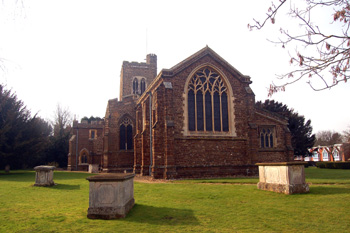
The church from the east March 2010
The earliest mention of education in Northill in any records held at Bedfordshire & Luton Archives & Records Service is in 1689 when the Overseers of the Poor were acting for the children of deceased pauper Richard Jennings - a receipt includes payment for their education [P10/18/12]. In the next century there are a number of references in churchwardens' accounts to a school in the parish [P10/5/2-4] - which seem to refer to the Sunday School: in 1708 there is a sum for: "mending the School stairs"; in 1780 one for "lime for the Schoolroom"; and in 1800 one for a "lock for the schoolroom door".
Volume 81 published by Bedfordshire Historical Records Society (2002) is a series of episcopal visitations undertaken in the first twenty years of the 18th century, edited by former County Archivist Patricia Bell. At each visitation a list of questions was sent out in advance, one of which enquired about the provision of schools in each parish. In 1796 it was reported that there was no school but in 1709: "John Baker teaches about 25 children, of which 14 are taught gratis at the Charge of the Curat [sic]". There is also a reference to schooling in Northill in the archives of the Archdeaconry of Bedford. In 1710 a glebe terrier [ABE2] notes: "The Schoolmaster is John Baker who lives at warden and hath a Salary by subscriptions of the Gentry in the Parish to teach poor children of this parish". In 1712 the incumbent reported: "The Charity Schole [sic] teaches 25 Children, besides 16 others, who re all instructed in their Church Catechism, and brought duly to Church". In 1717 the Vicar reported to the bishop: "We have one Charity-School (maintained by subscriptions) wherein about 18 Children (at Present) are taught to Read, and rehearse the church catechism. These are constantly brought to Church, when Divine service is read on Week Days". He repeated this in a return to the bishop of 1720.
In 1728 a Mrs.Hutchinson died and left £200 to the parish to be used to set up a charity to purchase land and the rents to be used to educate "as many poor and fatherless girls, inhabitants of that parish, as her trustees…should think convenient". The parish archives contain an account book which details payments from various charities [P10/25/26] and the Hutchinson charity used rents from land purchased at Thorncote, the payments in the account book running between 1739 and 1789.
Further references occur in the parish registers including: Isaac Carter, schoolmaster, buried 28 Apr 1755 and Joseph Lancaster, cordwainer, parish clerk, sexton and schoolmaster buried 6 Oct 1762.
In 1818 a Select Committee was established to enquire into educational provision for the poor. This was no doubt prompted, in part, by the recent foundation of two societies promoting education and specifically the building of schools. The Society for Promoting the Lancasterian System for the Education of the Poor was established in 1808 promoting schools run along the lines pioneered by Joseph Lancaster, who had himself copied those of Dr.Andrew Bell, in which older children taught their younger fellows. The Society was renamed the British and Foreign School Society in 1814,. It was supported by a number of prominent nonconformists, Lancaster himself was a Quaker, and sought to teach a non-sectarian curriculum. In answer to this perceived nonconformist takeover of local education the National Society was formed in 1811 to encourage the teaching of poor children along Anglican lines, including the catechism. The Select Committee sent a questionnaire to all parishes in the country asking for: particulars relating to endowments for the education of children; other educational institutions; observations of parish needs etc. The return for Northill recorded, oddly, that no endowment existed for educating children, despite the existence of the Hutchinson charity. This obvious error calls into question the reilability of the survey, perhaps the curate, who filled the questionnaire in, was ignorant of the Charity's existence, or perhaps to thought the parish would receive help if they did nor reveal its existence. The return also recorded the existence of a day school "in which 30 children are instructed at 4d. each, by the parish clerk". The curate ended by saying: "The poor are generally desirous of having their children taught to read, but being anxious to benefit by their labour, take them from school at too early a period".
In the country generally the number of schools built continued to grow over the next fifteen years so that by 1833 the government agreed to supplement the work of the two societies, and local benefactors, by making £20,000 per annum available in grants to help build schools. It also prompted another questionnaire to be sent to each parish in England asking for details of local educational provision. The reply from Northill ran as follows: "One Infant School (commenced 1830) in which 18 children of both sexes are instructed. Two Daily Schools, containing 18 boys and 16 girls. One Sunday School of 40 boys and 70 girls; all supported by subscription". In those days a Sunday School was just that, a school which met on a Sunday, usually in the church or nonconformist chapel or other similar building, teaching more than the religious topics with which they are associated today.
The next national enquiry was in 1846/7 when the Church of England made an enquiry as to all its church schools. This was against the background of a new Whig government which championed secular education and the increasing importance of nonconformists, particularly Wesleyan Methodist, and Roman Catholics in providing schools. The Northill return indicated that 40 boys and 82 girls attended Sunday school and a total of 39 boys and 40 girls attended five Dame's Schools.